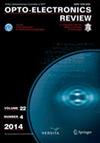用激光和氢退火降低锗硅波导的传输损耗
IF 0.9
4区 工程技术
Q3 ENGINEERING, ELECTRICAL & ELECTRONIC
引用次数: 0
摘要
锗硅(Ge-on-Si)平台已被证明是中红外光子学应用的优秀候选者,包括片上中红外光谱和生化传感。然而,由于Ge/Si界面处的穿线位错缺陷、λ < 8 μm的硅吸收以及由于侧壁粗糙度造成的表面散射,该平台经常受到高传播损耗的影响。本文研究了不同退火技术对cmos兼容工艺制备的锗硅波导的损耗降低效果。我们探索了在波导侧壁处使用局部激光退火,从而改变了影响。并采用氢环境下的非局部退火技术进行了比较。通过在同一芯片上制作波导和光栅耦合器结构,系统地表征了λ = 5 μm到λ = 11 μm波长范围内的传输损耗。通过改变波导长度(相同宽度)从L = 1 mm到L = 4 mm来进行切回测量。氢退火实验和激光退火实验都表明,传输损耗显著降低,分别高达27%和46%。这一发现为后处理技术铺平了道路,以减少Ge-on-Si平台的传播损耗,这将在未来实现各种片上中红外应用。本文章由计算机程序翻译,如有差异,请以英文原文为准。
Reduction of Ge-on-Si waveguide propagation loss by laser and hydrogen annealing
Germanium-on-Silicon (Ge-on-Si) platform has been demonstrated as an excellent candidate for mid-infrared photonics applications, including on-chip mid-infrared spectroscopy and biochemical sensing. However, this platform is often saddled by high propagation loss due to a combination of threading dislocation defects at the Ge/Si interface, absorption in the silicon for λ < 8 μm, and surface scattering due to sidewall roughness. This work investigates the effects on loss reduction through different annealing techniques on Ge-on-Si waveguides fabricated using CMOS-compatible processes. We explore the use of local laser annealing at waveguide sidewalls, whereby the fluence was varied. A non-local annealing technique in hydrogen ambient was also employed as comparison. The propagation losses for wavelengths, ranging from λ = 5 μm to λ = 11 μm, were systematically characterized by fabricating waveguide and grating coupler structures on the same chip. Cutback measurements were performed by varying the waveguide length (of the same width) from L = 1 mm to L = 4 mm. Both hydrogen and laser annealing experiments show marked reduction in the propagation loss, by up to 27% and 46% respectively. This finding paves the way for post-processing techniques to reduce propagation loss in Ge-on-Si platform, which will enable various on-chip mid-IR applications in the future.
求助全文
通过发布文献求助,成功后即可免费获取论文全文。
去求助
来源期刊

Opto-Electronics Review
工程技术-工程:电子与电气
CiteScore
1.90
自引率
12.50%
发文量
0
审稿时长
>12 weeks
期刊介绍:
Opto-Electronics Review is peer-reviewed and quarterly published by the Polish Academy of Sciences (PAN) and the Association of Polish Electrical Engineers (SEP) in electronic version. It covers the whole field of theory, experimental techniques, and instrumentation and brings together, within one journal, contributions from a wide range of disciplines. The scope of the published papers includes any aspect of scientific, technological, technical and industrial works concerning generation, transmission, transformation, detection and application of light and other forms of radiative energy whose quantum unit is photon. Papers covering novel topics extending the frontiers in optoelectronics or photonics are very encouraged.
It has been established for the publication of high quality original papers from the following fields:
Optical Design and Applications,
Image Processing
Metamaterials,
Optoelectronic Materials,
Micro-Opto-Electro-Mechanical Systems,
Infrared Physics and Technology,
Modelling of Optoelectronic Devices, Semiconductor Lasers
Technology and Fabrication of Optoelectronic Devices,
Photonic Crystals,
Laser Physics, Technology and Applications,
Optical Sensors and Applications,
Photovoltaics,
Biomedical Optics and Photonics
 求助内容:
求助内容: 应助结果提醒方式:
应助结果提醒方式:


